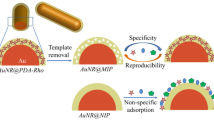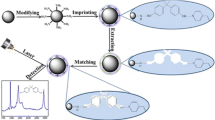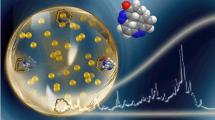Abstract
Novel molecularly imprinted polymers (MIPs) based on the technique of surface-enhanced Raman scattering (SERS) were successfully prepared. Firstly, ZnO nanorods were fabricated with Ag by reduction of Ag+ on the surface of the ZnO nanorods. Then, ZnO/Ag heterostructures were used as the substrate, rhodamine 6G was used as the template molecule, acrylamide was used as the functional monomer, ethylene glycol dimethacrylate was used as the cross-linker, and 2,2′-azobis(2-methylpropionitrile) was used as the initiator to prepare the ZnO/Ag MIPs (ZOA-MIPs). Through characterization analysis, it was proved that the novel ZOA-MIPs exhibited excellent SERS properties and selectivity. Under the optimal conditions, there was a good linear relationship (R 2 = 0.996) between the Raman signal (at 1654 cm-1) and the concentration of the templates, and the detection limit was 10-13 mol L-1. It was also proved that the ZOA-MIPs had the property of self-cleaning, resulting in good reusability. It is envisaged that the sensitivity of SERS coupled with the selectivity of MIPs could result in a promising chemosensor for practical applications.








Similar content being viewed by others
References
Li HJ, Wei X, Zhang YF, Xu YQ, Lu K, Li CX, et al. Rapid and sensitive detection of hemoglobin with gold nanoparticles based fluorescence sensor in aqueous solution. J Alloys Compd. 2016;685:820–7.
Qu YQ, Cheng R, Su Q, Duan XF. Plasmonic Enhancements of photocatalytic activity of Pt/N-Si/Ag photodiodes using Au/Ag core/shell nanorods. J Am Chem Soc. 2011;133:16730–3.
Rycenga M, Cobley CM, Zeng J, Li W, Moran CH, Zhang Q, et al. Controlling the synthesis and assembly of silver nanostructures for plasmonic applications. Chem Rev. 2011;111:3669–712.
Huang X, Jain PK, El-Sayed IH, El-Sayed MA. Gold Nanoparticles: interesting optical properties and recent applications in cancer diagnostics and therapy. Nanomedicine. 2007;2:681–93.
Fang Y, Seong NH, Dlott DD. Measurement of the distribution of site enhancements in surface-enhanced Raman scattering. Science. 2008;321:388–92.
Wang YQ, Yan B, Chen LX. SERS tags novel optical nanoprobes for bioanalysis. Chem Rev. 2013;113:1391–428.
Chen JM, Huang YJ, Kannan PL, Zhang L, Lin ZY, Zhang JW, et al. Flexible and adhesive surface enhance Raman scattering active tape for rapid detection of pesticide residues in fruits and vegetables. Anal Chem. 2016;88:2149–55.
Hossain MK, Kitahama Y, Huang GG, Han X, Ozaki Y. Surface-enhanced Raman scattering: realization of localized surface plasmon resonance using unique substrates and methods. Anal Bioanal Chem. 2009;394:1747–60.
Li JF, Huang YF, Ding Y, Yang ZL, Li SB, Zhou XS, et al. Shell-isolated nanoparticle-enhanced Raman spectroscopy. Nature. 2010;464:392–5.
Gutés A, Carraro C, Maboudian R. Silver Dendrites from galvanic displacement on commercial aluminum foil as an effective SERS substrate. J Am Chem Soc. 2010;132:1476–7.
Wang L, Li H, Tian J, Sun X. Monodisperse, micrometer-scale, highly crystalline, nanotextured ag dendrites: rapid, largescale, wet-chemical synthesis and their application as SERS substrates. ACS Appl Mater Interfaces. 2010;2:2987–91.
Ko H, Chang S, Tsukruk VV. Porous substrates for label free molecular level detection of nonresonant organic molecules. ACS Nano. 2009;3:181–8.
Camden JP, Dieringer JA, Zhao J, Van Duyne RP. Controlled plasmonic nanostructures for surface-enhanced spectroscopy and sensing. Acc Chem Res. 2008;41:1653–61.
Wu Y, Dong N, Fu S, Fowlkes JD, Kondic L, Vincenti MA, et al. Directed liquid phase assembly of highly ordered metallic nanoparticle arrays. ACS Appl Mater Interfaces. 2014;6:5835–43.
Yang L, Yan B, Premasiri WR, Ziegler LD, Negro LD, Reinhard BM. Engineering nanoparticle cluster arrays for bacterial biosensing: the role of the building block in multiscale SERS substrates. Adv Funct Mater. 2010;20:2619–28.
Zhou W, Yin BC, Ye BC. Highly sensitive surface-enhanced Raman scattering detection of hexavalent chromium based on hollow sea urchin-like TiO2@Ag nanoparticle substrate. Biosens Bioelectron. 2017;87:187–94.
Ko H, Chang S, Tsukruk VV. Porous substrates for label free molecular level detection of nonresonant organic molecules. ACS Nano 2009;3:181–188.
Zhao Y, Sun L, Xi M, Feng Q, Jiang CY, Fong H. Electrospun TiO2 nanofelt surface-decorated with Ag nanoparticles as sensitive and UV-cleanable substrate for surface enhanced Raman scattering. ACS Appl Mater Interfaces. 2014;6:5759–67.
Tang H, Meng G, Huang Q, Zhang Z, Huang Z, Zhu C. Arrays of cone-shaped ZnO nanorods decorated with Ag nanoparticles as 3D surface-enhanced Raman scattering substrates for rapid detection of trace polychlorinated biphenyls. Adv Funct Mater. 2012;22:218–24.
Chen T, Xing GZ, Zhang Z, Chen HY, Wu T. Tailoring the photoluminescence of ZnO nanowires using Au nanoparticles. Nanotechnology. 2008;19:17030–1.
Zang Y, He X, Li J, Yin J, Li K, Yue C, et al. Band edge emission enhancement by quadrupole surface plasmon-exciton coupling using direct-contact Ag/ZnO nanospheres. Nanoscale. 2013;5:574–80.
Jiang X, Li XL, Jia XF, Li GZ, Wang X, Wang GY, et al. Surface-enhanced Raman scattering from synergistic contribution of metal and semiconductor in TiO2/MBA/Ag(Au) and Ag(Au)/MBA/TiO2 assemblies. J Phys Chem C. 2012;116:14650–5.
Wang H, Ruan W, Zhang J, Yang B, Xu W, Zhao B, et al. Direct observation of surface-enhanced Raman scattering in ZnO nanocrystals. J Raman Spectrosc. 2009;40:1072–7.
Macias-Montero M, Borras A, Saghi Z, Espinos JP, Barranco A, Cotrino J, et al. Vertical and tilted AgNPs@ZnO nanorods by plasma-enhanced chemical vapour deposition. Nanotechnology. 2012;23:255–303.
Morton SM, Jensen L. Understanding the molecule-surface chemical coupling in SERS. J Am Chem Soc. 2009;131:4090–8.
Zhang B, Wang H, Lu L, Ai K, Zhang G, Cheng X. Large-area silver-coated silicon nanowire arrays for molecular sensing using surface-enhanced Raman spectroscopy. J Adv Funct Mater. 2008;18:2348–55.
Cheng C, Yan B, Wang SM, Li X, Zhou W, Yu T, et al. Fabrication and SERS performance of silver-nanoparticle decorated Si/ZnO nanotrees in ordered arrays. J ACS Appl Mater Interfaces. 2010;2:1824–8.
Li SJ, Ge Y, Piletsky SA, Turner APF. A zipper-like on/off-switchable molecularly imprinted polymer. J Adv Funct Mater. 2011;21:3344–9.
Wu YL, Yan M, Cui JY, Yan YS, Li CX. A Multiple-functional Ag/SiO2/organic based biomimetic nanocomposite membrane for high-stability protein recognition and cell adhesion/detachment. J Adv Funct Mater. 2015;25:5823–32.
Hu Y, Feng SL, Gao F, Eunice CY, Li C, Grant E, et al. Detection of melamine in milk using molecularly imprinted polymers-surface enhanced Raman spectroscopy. J Food Chem. 2014;176:123–9.
Kamra T, Zhou TC, Montelius L, Schnadt J, Ye L. Implementation of molecularly imprinted polymer beads for surface enhanced Raman detection. J Anal Chem. 2015;87:5056–61.
Kim J, Yong KJ. Mechanism study of ZnO nanorod-bundle sensors for H2S gas sensing. J Phys Chem C. 2011;115:7218–24.
Hao E, Schatz GC. Electromagnetic fields around silver nanoparticles and dimers. J Chem Phys. 2004;120:357–66.
Canamares MV, GarciaRamos JV, GomezVarga JD, Domingo C, SanchezCortes S. Comparative study of the morphology, aggregation, adherence to glass, and surface-enhanced Raman scattering activity of silver nanoparticles prepared by chemical reduction of Ag+ using citrate and hydroxylamine. Langmuir. 2005;21:8546–53.
Gao L, Li XY, Zhang Q, Dai JD, Wei X, Song ZL, et al. Molecularly imprinted polymer microspheres for optical measurement of ultra trace nonfluorescent cyhalothrin in honey. J Food Chem. 2014;156:1–6.
Yoshimatsu K, Reimhult K, Krozer A, Mosbach K, Sode K, Ye L. Uniform molecularly imprinted microspheres and nanoparticles prepared by precipitation polymerization: the control of particle size suitable for different analytical applications. J Anal Chim Acta. 2007;584:112–21.
Barakat N, Woo AM, Kanjwal KD, Choi MA, Khil KE, Kim MS. Surface plasmon resonances, optical properties, and electrical conductivity thermal hystersis of silver nanofibers produced by the electrospinning technique. Langmuir J Am Chem Soc. 2008;24:11982–7.
Tang H, Meng G, Huang Q, Zhang Z, Huang Z, Zhu C. Arrays of cone-shaped ZnO nanorods decorated with Ag nanoparticles as 3D surface-enhanced Raman scattering substrates for rapid detection of trace polychlorinated biphenyls. J Adv Funct Mater. 2012;22:218–24.
Li DY, He XW, Chen Y, Li WY, Zhang YK. Novel hybrid structure silica/CdTe/molecularly imprinted polymer: synthesis, specific recognition, and quantitative fluorescence detection of bovine hemoglobin. J ACS Appl Mater Interfaces. 2013;5:12609–16.
Chen Y, Donoghue MBO, Huang YF, Kang H, Phillips JA, Chen X, et al. A surface energy transfer nanoruler for measuring binding site distances on live cell surfaces. J Am Chem Soc. 2010;132:16559–70.
Yoshimi Y, Sato K, Ohshima M, Piletska E. Application of the “gate effect” of a molecularly imprinted polymer grafted on an electrode for the real-time sensing of heparin in blood. J Analyst. 2013;138:5121–8.
Yoshimi Y, Narimatsu A, Nakayama K, Sekine S, Hattori K, Sakai K. Development of an enzyme-free glucose sensor using the gate effect of a molecularly imprinted polymer. J Artif Organs. 2009;12:264–70.
Guo Y, Kang LL, Chen SN, Li X. High performance surface-enhanced Raman scattering from molecular imprinting polymer capsulated silver spheres. Phys Chem Chem Phys. 2015;17:21343–7.
Acknowledgements
This work was financially supported by the National Natural Science Foundation of China (nos 21277063, 21407057, 21407064, 21507045, and 21576111), the National Basic Research Program of China (973 Program, 2012CB821500), the Natural Science Foundation of Jiangsu Province (nos BK20140534 and BK20140535), the National Postdoctoral Science Foundation (no. 2014 M561595), and the Postdoctoral Science Foundation funded project of Jiangsu Province (no. 1401108C).
Author information
Authors and Affiliations
Corresponding author
Ethics declarations
Conflict of interest
The authors declare that they have no potential conflict of interest.
Electronic supplementary material
Below is the link to the electronic supplementary material.
ESM 1
(PDF 926 kb)
Rights and permissions
About this article
Cite this article
Li, H., Wang, Z., Wang, X. et al. Preparation of a self-cleanable molecularly imprinted sensor based on surface-enhanced Raman spectroscopy for selective detection of R6G. Anal Bioanal Chem 409, 4627–4635 (2017). https://doi.org/10.1007/s00216-017-0410-y
Received:
Revised:
Accepted:
Published:
Issue Date:
DOI: https://doi.org/10.1007/s00216-017-0410-y




